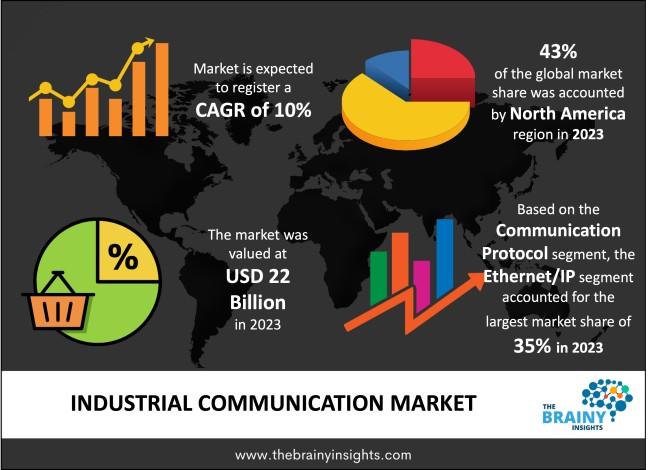
Introduction
The Industrial Communication Market is undergoing rapid transformation, fueled by the rise of Industry 4.0, smart manufacturing, and the increasing demand for real-time data exchange across industrial systems. Industrial communication enables seamless connectivity among machinery, control systems, and enterprise-level applications, playing a pivotal role in optimizing productivity, reducing downtime, and enabling predictive maintenance.
Market Overview
The global industrial communication market was valued at USD 22 billion in 2023 and is projected to grow at a compound annual growth rate (CAGR) of 10% from 2024 to 2033, reaching an estimated USD 57.06 billion by the end of the forecast period. This growth is driven by the proliferation of Internet of Things (IoT) in industrial applications, adoption of smart factories, and the increasing shift toward automated manufacturing systems.
Market Dynamics
The industrial communication market is experiencing robust growth due to the rapid advancement of Industry 4.0, increased automation in manufacturing, and the adoption of IIoT (Industrial Internet of Things). Companies are increasingly investing in industrial communication networks to enable real-time data exchange, process optimization, and predictive maintenance. Key driving factors include:
- Growing demand for smart factories
- Rising adoption of industrial automation
- Integration of wireless technologies with existing infrastructure
- Increased focus on energy efficiency and safety
However, challenges such as cybersecurity threats, high initial investment, and the complexity of integrating legacy systems pose significant barriers.
Regional Analysis
- North America: Dominates the market with strong adoption of advanced industrial solutions and robust infrastructure for automation.
- Europe: Significant presence of leading manufacturing companies and early adopters of Industry 4.0.
- Asia-Pacific: Fastest-growing region due to industrial expansion in China, India, and Southeast Asia, along with favorable government policies.
- Rest of the World: Gradual adoption with growing interest in digital transformation initiatives.
Segmental Analysis
By Component
- Hardware (Switches, Hubs, Routers, Gateways, etc.)
- Software
- Services
By Communication Protocol
- Fieldbus (PROFIBUS, Modbus, etc.)
- Industrial Ethernet (EtherCAT, PROFINET, Ethernet/IP)
- Wireless (Wi-Fi, Bluetooth, ZigBee, etc.)
By End-Use Industry
- Automotive
- Oil & Gas
- Energy & Power
- Food & Beverages
- Chemicals & Pharmaceuticals
- Others
List of Key Players
- Siemens AG
- ABB Ltd
- Cisco Systems, Inc.
- Rockwell Automation, Inc.
- Schneider Electric SE
- Honeywell International Inc.
- General Electric Company
- Advantech Co., Ltd
- Belden Inc.
- Moxa Inc.
Request PDF Brochure- https://www.thebrainyinsights.com/enquiry/sample-request/14628
Conclusion
The industrial communication market is poised for sustained growth with evolving technological landscapes and an increased focus on smart manufacturing. Companies that invest in flexible, scalable, and secure communication systems will be well-positioned to leverage the full potential of industrial automation.
